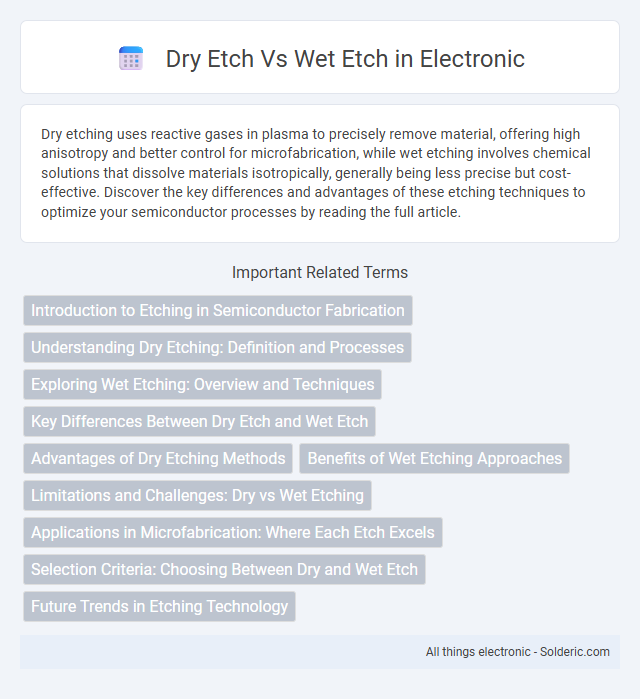Dry etching uses reactive gases in plasma to precisely remove material, offering high anisotropy and better control for microfabrication, while wet etching involves chemical solutions that dissolve materials isotropically, generally being less precise but cost-effective. Discover the key differences and advantages of these etching techniques to optimize your semiconductor processes by reading the full article.
Comparison Table
| Aspect | Dry Etch | Wet Etch |
|---|---|---|
| Process Type | Plasma or Reactive Ion Etching (RIE) | Chemical solution immersion |
| Etching Mechanism | Physical and chemical sputtering | Chemical reaction and dissolution |
| Precision | High precision and anisotropic | Lower precision, isotropic etching |
| Etch Profile | Vertical sidewalls | Undercut sidewalls |
| Material Selectivity | High selectivity possible with gas chemistry | Limited selectivity, depends on chemical solution |
| Control | Excellent control over etch depth | Less control, etch rate variable |
| Applications | Semiconductor device fabrication, microelectronics | Cleaning, surface preparation, bulk etching |
| Equipment Complexity | Complex, requires vacuum and plasma generation | Simple, requires chemical baths |
| Safety & Environmental Impact | Involves hazardous gases, requires proper exhaust | Hazardous chemicals, risk of chemical waste disposal |
Introduction to Etching in Semiconductor Fabrication
Etching in semiconductor fabrication is a critical process used to precisely remove material from the wafer surface to create intricate circuit patterns. Dry etch employs plasma or reactive gases to achieve high-resolution and anisotropic etching, essential for advanced device geometries. Wet etch utilizes liquid chemical solutions, offering faster material removal but less control over etch profiles, making it suitable for less complex structures in your semiconductor manufacturing workflow.
Understanding Dry Etching: Definition and Processes
Dry etching is a highly precise semiconductor fabrication technique that uses plasma or reactive gases to remove material from a substrate without liquid chemicals. This process enables anisotropic etching, allowing for fine pattern definition essential in microelectronics manufacturing. Understanding dry etching helps optimize your device fabrication by improving etch rate control, selectivity, and minimizing damage to underlying layers.
Exploring Wet Etching: Overview and Techniques
Wet etching involves using liquid chemical solutions to selectively remove materials from semiconductor wafers, offering precise control over etch depth and isotropic profiles. Common wet etching techniques include isotropic etching with acids like hydrofluoric acid for silicon dioxide and anisotropic etching using alkaline solutions such as potassium hydroxide for silicon substrates. This method is favored for its simplicity, cost-effectiveness, and suitability for cleaning and pattern transfer in microfabrication processes.
Key Differences Between Dry Etch and Wet Etch
Dry etch utilizes plasma or reactive gases to precisely remove material from semiconductor substrates, enabling anisotropic etching with high directional control, while wet etch employs liquid chemical solutions that typically result in isotropic material removal. You will find dry etching offers superior pattern fidelity and is ideal for fine-feature fabrication, whereas wet etching is generally faster and more cost-effective for bulk material removal. The choice between dry and wet etching directly impacts etch profile, selectivity, and process complexity in semiconductor manufacturing.
Advantages of Dry Etching Methods
Dry etching offers superior precision and anisotropy compared to wet etching, enabling the creation of intricate micro- and nanoscale patterns essential for semiconductor manufacturing. This method provides better process control with minimal undercutting and improved uniformity across wafers, enhancing device performance and yield. Furthermore, dry etching techniques such as reactive ion etching (RIE) reduce chemical waste and contamination risks, supporting cleaner and more environmentally sustainable fabrication processes.
Benefits of Wet Etching Approaches
Wet etching offers precise material removal with excellent selectivity, making it ideal for delicate microfabrication processes. This technique provides uniform etch rates over large surface areas and is cost-effective due to simpler equipment and lower chemical consumption. Its versatility in handling various materials and compatibility with batch processing enhance production efficiency in semiconductor manufacturing.
Limitations and Challenges: Dry vs Wet Etching
Dry etching faces limitations such as higher equipment costs, complexity in controlling anisotropy, and potential plasma-induced damage to delicate materials. Wet etching challenges include isotropic etching behavior, resulting in undercutting and limited precision on intricate patterns. Your choice between dry and wet etching depends on balancing these constraints with required etch profiles and material compatibility.
Applications in Microfabrication: Where Each Etch Excels
Dry etching excels in microfabrication applications requiring high precision and anisotropic patterns, such as semiconductor device manufacturing and MEMS fabrication, due to its ability to create vertical sidewalls with minimal undercutting. Wet etching is preferred for processes needing isotropic material removal or simpler pattern transfer, commonly used in cleaning, surface preparation, and bulk material etching for silicon and other substrates. Selecting between dry and wet etch depends on the desired feature resolution, material compatibility, and process control complexity specific to integrated circuit fabrication and microelectromechanical systems.
Selection Criteria: Choosing Between Dry and Wet Etch
Selection between dry etch and wet etch primarily depends on the desired etch profile, material compatibility, and precision requirements. Dry etching offers superior anisotropy and fine pattern control, making it ideal for high-resolution semiconductor fabrication, while wet etching is favored for its simplicity, lower cost, and suitability with isotropic material removal. Consideration of factors such as etch rate, selectivity, environmental impact, and equipment availability is crucial for optimal process selection in microfabrication.
Future Trends in Etching Technology
Future trends in etching technology emphasize dry etching techniques with advanced plasma and ion beam processes for enhanced precision and reduced environmental impact. Wet etching continues evolving through eco-friendly chemical formulations that minimize hazardous waste and improve selectivity on complex substrates. Your semiconductor manufacturing can benefit from hybrid etching strategies combining the strengths of both methods to meet the demands of nanoscale device fabrication.
Dry etch vs Wet etch Infographic

 solderic.com
solderic.com